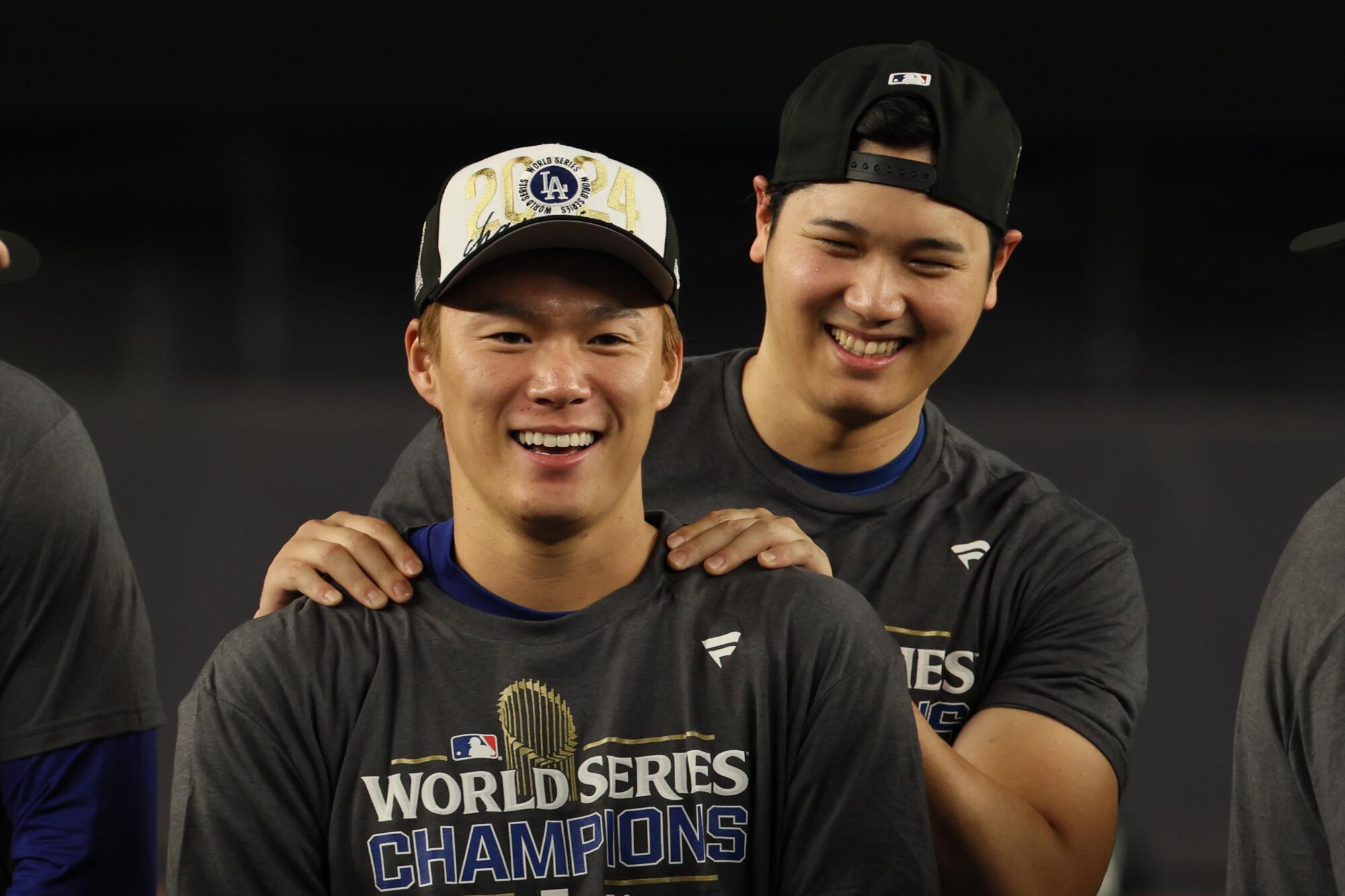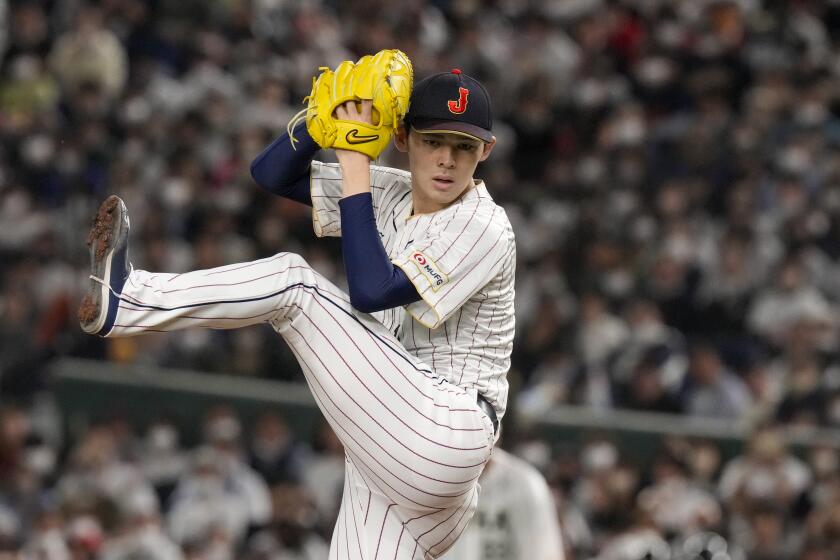
- Share via
When Roki Sasaki sat down for a sushi dinner with Dodgers officials and players last week, days before agreeing to sign with the club in one of the biggest coups of baseball’s offseason, Shohei Ohtani was one of several stars in attendance.
It wasn’t the first time the former Japanese teammates had dined together in recent months.
Throughout Sasaki’s highly anticipated and long-awaited posting process and free agency, the Dodgers knew the main pillars they wanted their courtship to be built upon:
That they were the premier destination for star players. That they were the league’s most adept franchise at helping players, particularly gifted young pitchers, develop tools and maximize their talent. That if Sasaki wanted to realize his goal of becoming one of the best players in the world, they were the best team for him.
Over the last year, there had been speculation around MLB that the Dodgers had a possible handshake agreement in place with pitcher Roki Sasaki.
All along, the Dodgers also knew who the best couriers of that message would be.
Sure, they wooed the 23-year-old phenom with presentations from their front office, coaching staff and player development department early in the process. They laid out a plan for his growth and ways they believed he could polish his tantalizing arsenal. They even employed one of their iconic owners, former Lakers star Magic Johnson, in their initial in-person meeting with Sasaki last month.
But at the heart of their pitch were testimonials from Ohtani and Yoshinobu Yamamoto, who were teammates with Sasaki during the 2023 World Baseball Classic.
In December, Ohtani and Yamamoto took Sasaki to dinner, according to multiple people with knowledge of the situation not authorized to speak publicly. The topics discussed are unknown. But weeks later, the meal has become one of the many examples of how Dodgers players pushed to bring Sasaki to Los Angeles, with stars such as Mookie Betts, Will Smith and Tyler Glasnow joining Ohtani and Yamamoto in helping sell Sasaki on the idea of beginning his big-league career in Dodger blue.

“They wanted him to know how much they were looking forward to having him join them. They wanted him to hear the message,” said one person with knowledge of the recruiting efforts not authorized to speak publicly. “The players caring that much, I think that was meaningful to him. He didn’t have to worry about how he would be perceived. He would be perceived great. And they all wanted him here.”
In the early stages of Sasaki’s free agency this winter, the influence of current players in the pitcher’s decision-making process was limited.
According to his agent, Joel Wolfe of Wasserman Media Group, Sasaki requested that no players participate in his opening round of face-to-face meetings, which he held with at least eight teams at Wasserman’s offices in Southern California in December. Instead, Sasaki’s initial impression of clubs was formed through presentations with executives, coaching staff members and other officials from his list of candidates.
Ahead of each session, Sasaki gave each team the same “homework assignment,” as Wolfe termed it, asking them to identify why they thought Sasaki’s fastball velocity dipped in Japan last year — when his typically triple-digit heater sat closer to 96 to 97 mph — and what their plan would be to rectify it.
The Dodgers’ ability to put off long-term payments while reaping short-term benefits is raising new fears about a competitive imbalance in a sport already lacking league-wide parity.
“It was a great opportunity for the teams to really show what they specialize in,” Wolfe told reporters last month. “It enabled them to show how they can analyze and communicate information with him, and really showed where he was coming from in analyzing and creating his selection criteria in looking at different teams.”
To the Dodgers, the exercise landed in what officials believed to be a “sweet spot” for the organization. From the outset, they aimed to make their highly touted pitching development apparatus a key component of their appeal to Sasaki — highlighting their veteran staff of coaches, an army of analysts and evaluators, and an arsenal of advanced training tools and technologies that will only grow once the team’s extensive offseason renovations to Dodger Stadium are complete.
And as they laid out their plan to the soft-spoken yet inquisitive young right-hander, they impressed him enough to become one of three teams that secured a second meeting.
From there, Dodgers players began backing up everything club brass had been talking about. There was Sasaki’s dinner with Ohtani, who worked with Dodgers staff to progress through a pitching rehabilitation from Tommy John revision surgery last year, and Yamamoto, who steadily improved last season after making a similar jump from Japan’s Nippon Professional Baseball league.
“Shohei and Yoshi were very helpful, very influential, very involved with him on a personal level,” said the person with knowledge of the Dodgers’ recruitment.
Sasaki also had a brief but informative exchange with Glasnow, a fellow Wolfe client.
Roki Sasaki’s decision to play for the Dodgers, on what will start as a standard minor-league contract, instantly transforms the club’s short- and long-term future.
“I called my agent and he was like, ‘Oh, I’m with Roki.’ I was like, ‘Oh, I’ll say what’s up,’” Glasnow told the Foul Territory podcast recently.
After the call, Glasnow sent Sasaki a longer endorsement of the Dodgers.
“If one of your main goals is to become the best pitcher you can possibly be, development-wise, scouting report-wise and all that stuff, I was like, this is the place for you,” Glasnow said, and added that he told Sasaki whether his motivation was “money or winning, this is the best place to grow as a baseball player. That was my message.”
That all set the stage for the main event, with the Dodgers hosting their second Sasaki meeting three days before he signed. This time, with three finalists in the Dodgers, San Diego Padres and Toronto Blue Jays, the pitcher allowed players to take part in the process.
Some fans won’t be happy with Roki Sasaki signing with the Dodgers, but many team owners will be happy to see Shohei Ohtani and the Dodgers come to town.
And as the Dodgers prepared for their final opportunity to sell Sasaki on their vision, they made sure as much of their roster as possible was involved.
When Sasaki arrived at the home of Dodgers co-owner Peter Guber for last week’s meeting — held there, with the help of a private sushi chef, because of the renovations at Dodger Stadium — he was greeted by about half a dozen players. Over the course of the evening, each began hammering home reasons for him to sign with Los Angeles.
Smith, the starting catcher, spent time discussing the club’s renowned game-planning process and how he has built rapport with the star-studded pitching staff.

Betts stood up at one point and delivered a lengthy speech that one person in attendance recalled lasting almost 10 minutes, during which the former most valuable player extolled his time in Los Angeles and the “special” place it has become in the second chapter of his career.
For players who couldn’t attend — Yamamoto, who was out of town, among them — the Dodgers solicited videos to show to Sasaki, with each minute-long clip emphasizing the perks of playing for a franchise with almost unlimited resources and a winning culture created by the current ownership that has spanned more than a decade. Between the players in attendance, which included Freddie Freeman and Tommy Edman, and the video presentations, Sasaki heard from about three-fourths of the roster.
Roki Sasaki could be the greatest Japanese pitcher ever. He hopes the Dodgers can turn him into just that, even if it means Shohei Ohtani outshines him.
No one’s presence loomed larger than Ohtani’s, as the voice in the room who personally could relate to Sasaki the most.
Once upon a time, Ohtani was in Sasaki’s shoes: a generational talent from Japan’s rural northwest Iwate prefecture, making the jump to MLB at 23 years old, trying to decipher which club would be best for the start of his big-league career.
Since then, Ohtani has blossomed into the biggest name in baseball. He won rookie of the year and three MVPs. He perfected his craft as a two-way player in a fashion the sport hadn’t witnessed since Babe Ruth. He learned how to successfully transition to the U.S., all while handling his status as an international celebrity.
It wasn’t until last year, however, when Ohtani signed his $700-million contract with the Dodgers, that he tasted what he’d craved most in the majors, winning the World Series after missing the playoffs in all six of his seasons with the Angels.
Throughout the year, Ohtani lauded his experience in the organization. And throughout Sasaki’s free agency, his impressions of the club evidently resonated with the young pitcher.
The Dodgers pull off another big win in free agency, agreeing to sign Japanese sensation Roki Sasaki to bolster their already formidable starting pitching staff.
It was enough to alleviate one of the few unknowable questions that accompanied the Dodgers’ pursuit of Sasaki: Would the budding ace feel playing with the Dodgers would put him in Ohtani’s shadow, and prompt him to go somewhere he could forge his own path? Or did he view the prospect of joining forces with Ohtani, the consensus best player in the world, as another boon to his career?
The answer came less than 72 hours later, when Sasaki announced he would be in L.A..
Sasaki has yet to discuss his recruiting process publicly, or how much the impact of Dodgers players swayed his decision. But within the team, much credit has been given to the efforts of the players, and Ohtani and Yamamoto’s influence especially.
“You can tell that he’ll love being around Yoshi and Shohei,” Betts told reporters in Tokyo this week during a promotional tour in Japan, according to the Associated Press. “I think that will really help him a lot.”
More to Read
Are you a true-blue fan?
Get our Dodgers Dugout newsletter for insights, news and much more.
You may occasionally receive promotional content from the Los Angeles Times.















